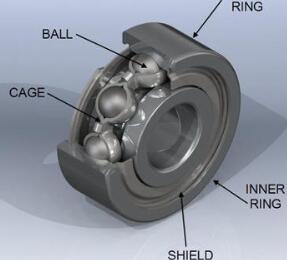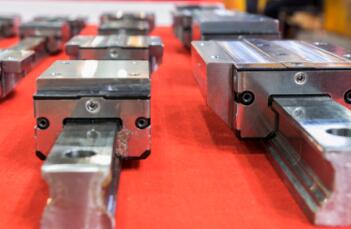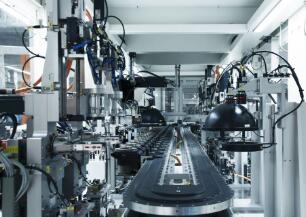The Future of Bearings: Trends and Forecast
Discover the latest trends and future predictions for the bearing industry.
Learn about key drivers, inhibitors, and opportunities for investment and expansion.
With a projected CAGR of 7.6% from 2021 to 2026, this industry is growing rapidly, and businesses need to stay ahead of the curve.
Did you know that the global bearing market was valued at USD 41.83 billion in 2020 and is expected to reach USD 61.96 billion by 2026?
-Market size and growth predictions
-Key drivers and inhibitors of the industry
-Opportunities for investment and expansion
In this article, we will delve into the key drivers and inhibitors of the industry, as well as opportunities for investment and expansion.
Whether you are an established player in the industry or looking to invest, this article will provide valuable insights into the future of bearings.
Technological Advancements in Bearing Design

A. Development of Smart Bearings with Embedded Sensors
The use of smart bearings with embedded sensors is a recent technological advancement that has revolutionized the way bearings are used in various industries.
These bearings are equipped with sensors that can detect a variety of parameters, including temperature, vibration, pressure, and load.
The data collected by the sensors can be analyzed in real-time, providing crucial information about the condition of the bearing, as well as the machinery it is being used in.
One of the main benefits of smart bearings is their ability to provide early warning signs of impending failure.
By continuously monitoring the condition of the bearing, any signs of wear or damage can be detected early on,
allowing for preventative maintenance to be carried out before more serious damage occurs.
This can help to increase the lifespan of the bearing, as well as reduce the risk of costly downtime and repairs.
Another advantage of smart bearings is their ability to provide valuable data that can be used to optimize the performance of the machinery they are used in.
By analyzing the data collected by the sensors, engineers can gain a better understanding of how the machinery is performing,
identify areas for improvement, and make adjustments to improve efficiency and reduce energy consumption.
B. Miniaturization of bearings for micro-machinery applications
The miniaturization of bearings is a crucial aspect of modern engineering, as it enables the development of micro-machinery applications.
These applications are becoming increasingly important as technological advancements continue to push the boundaries of what is possible in various fields.
Miniaturized bearings are essential components in these applications, as they allow for precise and smooth movement of small components, such as gears, pulleys, and linkages.
One of the key challenges in miniaturizing bearings is maintaining their performance characteristics while reducing their size.
As bearings get smaller, the forces and stresses that they must endure become greater, making it harder to maintain their load-carrying capacity and durability.
This has led to the development of new materials and manufacturing techniques that are specifically designed for miniaturized bearings.
In recent years, ceramic materials have become increasingly popular for miniaturized bearings, as they offer several advantages over traditional steel bearings .
Ceramics are harder and more wear-resistant than steel, making them better suited for applications where high speeds and loads are involved.
They are also less prone to corrosion and can operate in harsher environments than steel bearings.
C. Advances in bearing materials and coatings
Advances in bearing materials and coatings have led to significant improvements in the performance and durability of bearings.
Bearing materials have evolved, with new materials being developed to meet the demands of modern engineering applications.
The most common bearing materials are steel and ceramics, but advancements in materials science have led to the development of new materials with improved properties.
One such material is polymer-based bearings, which are becoming increasingly popular in applications where low friction, high wear resistance, and corrosion resistance are required.
These bearings are often used in the food and beverage industry, where they offer several advantages over traditional steel bearings,
such as the ability to operate in wet environments without rusting or corroding.
Another key development in bearing materials is the use of nanocomposite materials.
These materials are made by embedding nanoparticles into a matrix material, which can improve the mechanical and tribological properties of the material.
Nanocomposites have been shown to reduce friction and wear in bearings, making them more durable and reliable.
Emerging Applications of Bearings

A. Growth in robotics and automation
The growth of robotics and automation has driven the demand for high-performance bearings that can withstand the harsh operating conditions of these applications.
Bearings are critical components in robotics and automation, as they provide smooth and precise movement of robotic arms, grippers, and other components.
One of the key challenges in designing bearings for robotics and automation is ensuring their reliability and durability.
These applications often require high speeds, loads, and accelerations, which can cause excessive wear and tear on bearings.
To address this challenge, engineers are developing new bearing materials and coatings that can withstand these harsh operating conditions.
Another important aspect of bearings in robotics and automation is their ability to operate with high precision and repeatability.
Bearings must be able to maintain tight tolerances and minimize vibration and noise to ensure accurate and reliable performance.
Advances in bearing design, such as the use of ceramic and hybrid bearings, have enabled improved precision and repeatability in these applications.
B. Increasing demand for renewable energy sources
The increasing demand for renewable energy sources, such as wind and solar power, has driven the development of new bearing technologies that can withstand the harsh operating conditions of these applications.
Bearings are essential components in wind turbines, solar panels, and other renewable energy systems, as they provide smooth and reliable rotation of turbines and other components.
One of the key challenges in designing bearings for renewable energy applications is their ability to operate in harsh environments, such as high temperatures, high speeds, and corrosive conditions.
To address this challenge, engineers are developing new bearing materials and coatings that can withstand these harsh operating conditions and extend the lifespan of the bearings.
Another important aspect of bearings in renewable energy applications is their ability to reduce friction and energy consumption.
Bearings that can operate with low friction can help to increase the efficiency of wind turbines and other renewable energy systems, reducing the amount of energy required to generate power.
C. Potential use of bearings in space technology
Bearings are also critical components in space technology, where they play a crucial role in the precise and reliable movement of spacecraft components.
The extreme operating conditions of space, such as vacuum, radiation, and extreme temperatures,
require bearings that can withstand these harsh environments while maintaining their performance and reliability.
One of the key challenges in designing bearings for space applications is their ability to operate in the absence of lubrication.
Bearings that can operate without lubrication can help to reduce the weight and complexity of space systems, while also improving their reliability and lifespan.
Industry Challenges and Opportunities

A. Sustainability and environmental concerns
One of the significant challenges faced by many industries today is the need to operate sustainably and address environmental concerns.
With the increasing focus on climate change and environmental degradation, consumers, investors, and regulatory bodies are demanding that industries take steps to reduce their impact on the environment.
One opportunity for industries is to invest in clean technology and renewable energy sources.
This can help reduce their carbon footprint and increase efficiency while also reducing costs over the long term.
Another opportunity is to implement sustainable practices throughout the supply chain, from sourcing raw materials to disposing of waste.
Additionally, companies can take advantage of the growing demand for environmentally friendly products and services.
This can include using eco-friendly materials, reducing packaging waste, or offering recycling programs.
By adopting sustainable practices and products, companies can differentiate themselves from competitors and build a loyal customer base.
B. Global market trends and competition
In today's globalized economy, industries face intense competition from both domestic and international markets.
This can create challenges for businesses trying to maintain profitability while keeping up with changing consumer preferences and market trends.
One opportunity for industries is to embrace new technology and innovation to stay ahead of the curve.
By investing in research and development, companies can create new products and services that meet emerging consumer needs and preferences.
This can help companies differentiate themselves from competitors and increase their market share.
Another opportunity is to expand into new markets, either domestically or internationally.
By diversifying their customer base, companies can reduce their dependence on any single market and mitigate the risks associated with economic fluctuations or changing consumer preferences.
C. Innovation and collaboration in the industry
As industries become more complex and interdependent, collaboration and innovation have become increasingly important.
By working together, companies can leverage each other's strengths and expertise to create new products and services that meet emerging consumer needs.
One opportunity for industries is to embrace open innovation and collaborate with other companies, startups, or academic institutions.
This can help companies access new ideas and technologies that they may not have developed on their own.
Additionally, collaboration can help companies reduce costs and increase efficiency by sharing resources and expertise.
Another opportunity is to adopt agile development methodologies to improve innovation and speed to market.
By breaking down silos and promoting collaboration between different teams and departments, companies can reduce the time it takes to develop and launch new products and services.
Additionally, adopting agile methodologies can help companies quickly respond to changing market trends and consumer preferences.
Future Forecast of the Bearing Industry
A. Market size and growth predictions
The bearing industry is expected to see steady growth in the coming years, with a projected CAGR of 7.6% from 2021 to 2026.
This growth can be attributed to several factors, including the increasing demand for bearings in the automotive, aerospace,
and industrial sectors, as well as the growing trend toward automation and digitization.
The global bearing market was valued at USD 41.83 billion in 2020 and is expected to reach USD 61.96 billion by 2026.
The Asia-Pacific region is expected to be the fastest-growing market, with China and India being the key contributors to growth.
In terms of bearing type, the ball bearings segment is expected to hold the largest market share due to its widespread use in various applications.
B. Key drivers and inhibitors of the industry
The key drivers of the bearing industry include the growing demand for automation and digitization,
the increasing use of bearings in the automotive and aerospace industries, and the need for energy-efficient and reliable bearings in industrial applications.
The automotive industry is a significant driver of the bearing industry, as bearings are critical components in various automotive applications,
including engines, transmissions, and wheels. Additionally, the aerospace industry is also a key driver, as bearings are used in aircraft engines, landing gear systems, and other critical components.
However, the industry also faces some inhibitors, including the volatility of raw material prices, intense competition from low-cost manufacturers, and the impact of the COVID-19 pandemic.
Fluctuations in raw material prices can affect the profitability of bearing manufacturers, while low-cost manufacturers from countries such as China can pose a threat to established players in the industry.
C. Opportunities for investment and expansion
The bearing industry presents several opportunities for investment and expansion, particularly in emerging markets such as China and India.
As these countries continue to develop and industrialize, the demand for bearings is expected to grow significantly.
Investment in research and development is also critical for the industry, particularly in the areas of automation and digitization.
Bearings play a vital role in various automation applications, such as robotics and machine tools,
and companies that invest in developing new and innovative products in this area are likely to see significant growth.
Additionally, there are opportunities for companies to expand their product offerings to include more energy-efficient and environmentally friendly bearings.
With the increasing focus on sustainability and reducing carbon emissions,
there is a growing demand for bearings that can help improve the efficiency of machines and reduce energy consumption.
Conclusion
In conclusion, the bearing industry is expected to experience significant growth in the coming years.
By understanding the key drivers, inhibitors, and opportunities for investment and expansion, businesses can position themselves for success.
Applying the tips and insights shared in this article can help businesses stay ahead of the curve and thrive in a rapidly evolving industry.





